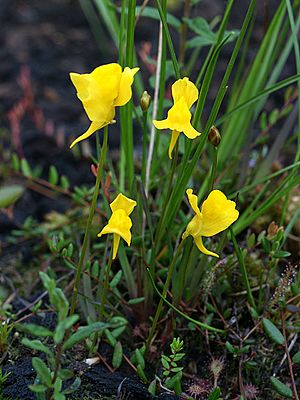Horned bladderwort facts for kids
Quick facts for kids Horned bladderwort |
|
|---|---|
 |
|
| Scientific classification | |
| Genus: |
Utricularia
|
| Species: |
cornuta
|
| Synonyms | |
|
|
The Utricularia cornuta, also known as the horned bladderwort, is a fascinating plant. It is a small to medium-sized carnivorous plant. This means it gets some of its nutrients by trapping and eating tiny creatures.
The horned bladderwort is likely a perennial plant. This means it lives for more than two years. It belongs to a special group of plants called Utricularia. You can find U. cornuta in North America. It grows in places like the Bahamas, Cuba, Canada, and the United States.
This plant loves wet places. It grows in marshes, swamps, and shallow pools. You will usually find it in lower areas, not high up in mountains. A scientist named André Michaux first described this plant in 1803.
Contents
What is a Carnivorous Plant?
A carnivorous plant is a plant that eats insects or other small animals. They usually grow in poor soil. This soil does not have enough nutrients. So, the plants catch prey to get the extra food they need.
How Bladderworts Catch Food
Bladderworts like Utricularia cornuta are special. They have tiny traps called bladders. These bladders are usually underground or underwater. When a small insect or water creature touches a trigger hair, the bladder opens quickly. It sucks in the prey and water. Then, the bladder closes, trapping the meal inside. The plant then digests its prey.
Where the Horned Bladderwort Lives
The horned bladderwort is found only in North America. This means it is endemic to this region. Its range stretches across many areas.
Specific Locations
- The Bahamas: A group of islands in the Atlantic Ocean.
- Cuba: The largest island in the Caribbean.
- Canada: Found in both eastern and western parts.
- United States: Common in the northeastern, north-central, and southeastern states.
It prefers very wet habitats. These include bogs, swamps, and the edges of ponds. The plant often grows partly in water or in very damp soil.
Life Cycle of the Horned Bladderwort
Like many plants, the horned bladderwort has a life cycle. It grows from a seed or from parts of an older plant. It then develops its unique bladders for trapping food.
Reproduction
Utricularia cornuta produces flowers. These flowers help the plant make seeds. The seeds can then grow into new plants. This helps the species continue to thrive in its wet environments.


